The Top 10 Movies That Were Basically Uncredited Superhero Comic-Book Adaptations
 |
Although it may be hard to imagine, there was once a time when “comic book movies” were not a ubiquitous film genre each year. The reason is that comic book movies (at least the superhero ones, as opposed to those more like Ghost World , Virus, or A History of Violence) used to be financially risky and treated with derision. Sometimes the only way filmmakers could get a superhero movie made before the boom was to pretend it wasn’t based off comic books. This had the additional economic incentive of not licensing any source material.
Hollywood’s attitude shifted once it realized there was a sustainable market for superhero movies with quality production values at the dawn of the twenty-first century. Now studios’ problem was that the film rights to all the popular comic books had already been snapped up years ago for peanuts. This led to a new wave superhero movies with their serial numbers filed off. Even television got in on the unlicensed superhero mania. (Watch the first season of Heroes for a great X-Men analogue, then cringe as the next three seasons manage to make the comics’ worst aspects even more terrible!)
These are “stealth” superhero movies. They excite audiences and critics by ostensibly promising brand new stories while concealing that they’re essentially derivative. The unlicensed adaptation of Batman vs. The Incredible Hulk that stole the name of a vintage cartoon even took home a bunch of Oscars! Tweaking existing properties just enough to count as transformative works isn’t anything new. (That’s how a Twilight fanfic became 50 Shades of Grey.) It’s even how most comic books get their ideas in the first place. For example, Squadron Supreme is a barely disguised imitation of DC’s Justice League, even though Marvel already has The Avengers.
It’s just more noteworthy when the copying jumps mediums directly, like we’ll discuss below. Often filmmakers will stitch together a few different comic book properties to make the borrowing less explicit. Of course, many of these cinematic similarities could’ve easily been subconscious homages or inadvertent coincidence. Maybe this trend is irrelevant since all of culture is a remix anyway? But you didn’t come here for reasonable explanations, so let’s get right down to the esoteric apophenia!
11. The Matrix = The Invisibles
The most well known stealth comic book movie may be The Matrix. On the superficial end of things, the Wachowskis hired comic book illustrators Geoff Darrow and Steve Skorce to do preproduction work. More importantly, they swiped The Invisibles wholesale as if it was a pie left unguarded on a windowsill. Both are about counterculture freedom fighters travelling betwixt different planes of reality, pitted against awareness-restricting inhuman creatures disguised as G-men, in a quest to restore equilibrium. It is an open secret that trade paperbacks of the series were even distributed to the production team for reference. Rather than point out specific examples of glaring similarities, I refer you to this page which already has a thorough comparison. The biggest difference between the two is that Laurence Fishburne’s character is named after The Sandman’s Morpheus instead of King Mob. Okay, they also threw in a ton of cyberpunk so the eventual movie adaptations of The Sprawl Trilogy and Snowcrash will seem even less inspired.
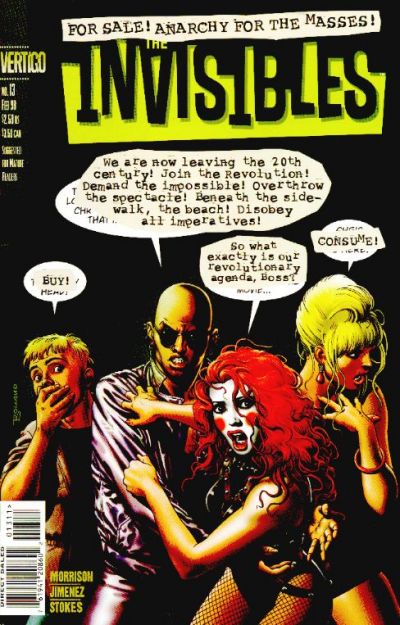 |
This vexed Grant Morrison once he found out. Since The Invisibles was published by Vertigo, which is an imprint of DC Comics, which is owned by Warner Brothers, which produced The Matrix, he should’ve been in the ideal position to earn some adaptation royalties from the blockbuster franchise. Instead he was tackily asked to write a new story for The Matrix website. When he (like most audiences) was disappointed that the sequels didn’t fully explore the transcendental themes of the original, Morrison unleashed one of the most epic burns upon the Wachowski siblings: “They should have kept on stealing from me.” He did not dignify Branded with a zinger.
It should probably be ranked higher up, but I wanted to get it out of the way first before diving into the more esoteric stuff. I’m even going to throw in a bonus entry beyond the standard top ten in case you’re already bored of listicles comparing The Matrix wth The Invisibles!
10) Darkman = Batman + V For Vendetta
Sam Raimi wanted to direct a Batman movie, but WB thought the first two Evil Dead movies were insufficient experience. Then he wanted to make The Shadow but couldn’t get the rights. So instead he made Darkman at Universal as a consolation. (Ironically Universal would also make Russell “Highlander” Mulcahy’s underrated The Shadow.) So Darkman was supposed an adaptation of an established superhero but its recognizable elements had to be drastically reduced and rejiggered for legal reasons, although not necessarily more than Hollywood’s typical approach to licensed adaptations. He’s still an urban avenger in a corrupt metropolis like his inspirations, although horror elements were emphasized over superheroism. Darkman definitely kept the same silhouette as the Shadow. Raimi emphasized the dynamism of scenes to make watching the film feel like reading a comic book.
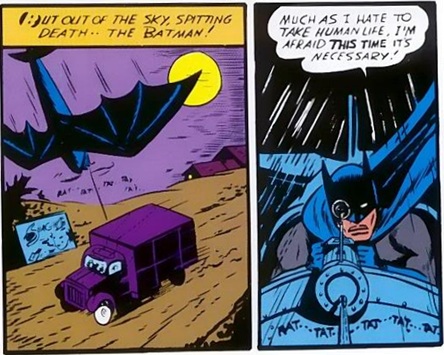 |
Just like the Shadow and the Golden Age Batman he inspired, Darkman isn’t shy about killing criminals. As a fedora-clad man consumed by revenge after having all his skin burnt off, Darkman shares many parallels with fellow anti-hero V of V For Vendetta (minus his penchant for political terrorism and Stockholm Syndrome). (His bandaged face might have inspired future Bat-rogue Hush, which may be the only point in Hush’s favor.) Julie Hastings is the former Dr. Peyton Westlake’s tether to humanity and rage trigger when threatened, just as Betty Ross is to the Hulk, but with more agency like The Shadow’s Margo Lane. Naturally, the villian is an immoral industrialist obsessed by real estate like Lex Luthor. Darkman’s synthetic skin masks that allow him to impersonate anyone (inexplicably including their voices) appear to be a nod to B-list villain the Chameleon, given that Sony later let Raimi fulfill his childhood dream of making Spider-Man movies. (If Sony made both, would they tie-in Darkman’s origin to Chameleon in their apparently still happening Sinister Six movie?) Or, to return to increasingly the tenuous Batman connection, his mastery of disguise could reference Clayface or the more obscure False Face.
Then the studio diced it up during editing, which is akin to the editorial mandates that plague your favorite comics.
9) Meteor Man = Darna + Black Lightning
Before Steel, Spawn, and Blade, the first Black superhero to headline a major movie was Meteor Man. (Well, besides Abar: The First Black Superman, of course.) Jefferson Reed is a mild-mannered high school teacher who gains a myriad of amazing superpowers after being struck by a meteorite that looks identical to Kryptonite. Writer/director/star Robert Townsend draws Superman parallels (since he was the only superhuman with a blockbuster movie series at the time), but his origin makes him more like Darna (or Moonstone minus the sociopathy). “Who is Darna,” you ask? She’s the gender-swapped Filipina version of Captain Marvel (not the one who used to go by Ms. Marvel) who gains a myriad of amazing superpowers from swallowing a small white meteorite. She’s been a star of comics, movies, and TV shows since the late 40’s yet remains obscure outside of the Philippines, probably because she lacks Meteor Man’s canine telepathy.
 |
Meteor Man uses his powers to free his impoverished urban neighborhood from the grip of gangs. Townsend intended the film to be inspirational to underprivileged kids, but undercut his message by making it as campy as real life isn’t.
Furthermore, he hurt the odds of Black Lightning being taken seriously in Hollywood. As DC’s first black character to star in his own comic book, BL’s stories tended to be more realistic than Meteor Man (or as realistic as they can be when he’s a metahuman living in the same city as Superman). Black Lightning was a high school teacher named Jefferson Pierce, who used his electricity powers to free his impoverished urban neighborhood from the grip of gangs. Black Lightning’s major foes were The 100 (not the ones on The CW) led by the albino African-American Tobias Whale, whereas Meteor Man’s main foes were the Golden Lords with bleached blond hair. So each gang has color symbolism to show that they’re complicit in perpetuating the effects of racism in inner cities.
This wouldn’t be the first time Black Lightning’s mass media thunder was stolen. Rather than pay his creator, Tony Isabella, royalties to include him in Challenge of the Super Friends, Hanna-Barbera replaced him with the suspiciously similar Black Vulcan (not Tuvok), so named because Black Jupiter would’ve made too much sense.
8) Kill Bill Vol. I = Wolverine
It’s pretty clear that Quentin Tarantino is a fan of obscure ’70s B-movies, but his fondness for comic books tends to be more subdued. (Mr. Orange and Bill are his mouthpieces for the most direct references.) So when audiences saw Uma Thurman’s vengeful Kill Bill protagonist in a yellow and black suit, they picked up on it as an obvious homage to Buce Lee in Game of Death. But isn’t there also a comic book asskicker famous for dressing in yellow and black? (If you answer Yellowjacket, sit in the corner.) Yup, her outfit serves double duty to equate her with the most famous mutant of all, Wolverine. (Even Rocket Racoon’s movie costume is also much closer to Wolverine’s costume than what he wore before joining the GotG, as a shorthand to signify he’s the team badass and rub it in that the costume designers for the X-Men films are lousy at their job.)
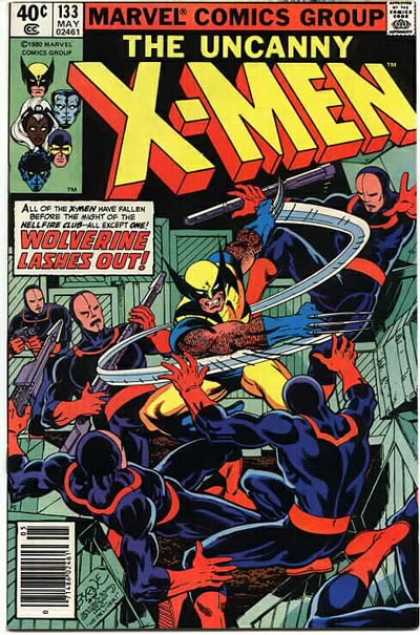 |
The Bride has a mysterious past doing dirty deeds as part of DiVAS just as Wolverine has plenty of skeletons in his closet from doing black ops as part of his convoluted past working for the Canadian government. After she had a falling out with her former co-workers, they fridged her husband to be on their wedding day. Wolverine likewise had a falling out with his co-worker, Sabretooth, after he fridged his girlfriend, Silver Fox, on his birthday. Although she doesn’t share his regenerative healing factor, she’s still hardy enough to survive a close-range assassination by five expert assassins and a subsequent ninja melee. Wolverine often considers the Weapon X Project’s medical experiments on him to be as traumatic as rape (which is undermined by the retcon that he volunteered), whereas the Bride is subjected to non-allegorical rape while in a coma in a hospital.
Also, her Hattori Hanzo katana is just as unstoppable as his Adamantium claws, and Bill is reminiscent of the Weapon X director in the sense that he’s a mysterious looming presence that made her who she is but is ultimately a poor match for her. Elle Driver and O-Ren Ishii seem more akin to the more physically formidable Sabretooth and Silver Samurai. (I guess Budd could be Maverick.) The epic bloodbath with the Crazy 88 at the House of Blue Leaves feels like the perfect recreation of one of numerous Wolverine vs. The Hand ninja clan brawls. Meanwhile in The Wolverine, which is officially based in part on his mini-series drawn by Frank Miller, Wolverine gets turned into a pin cushion by a bunch of cannon fodder ninjas instead of vice versa. When it comes to cinematic costumes and ninja slayings, it’s the Bride who comes out on top as the best there is at what she does.
7) The Incredibles = Fantastic Four +Watchmen
It’s immediately apparent that Brad Bird’s The Incredibles is a movie inspired by comic books. It was definitely sold as a costumed superhero film. What’s less apparent is how much Pixar’s original superhero movie relies upon well known properties for its characters and plot. The superhero family quartet is patterned after Fantastic Four and hit theaters a year ahead of Fox’s inferior official version. Patriarch Mr. Incredible is a blue collar tank just like the Thing. He’s married to Elastigirl who has Mr. Fantastic’s stretchy powers. (If you ship Mr. Fantastic and the Thing, this is probably the most mainstream your preferred slashfic will be.) Bird threw in some Doom Patrol by removing a hyphen to their Elasti-Girl and changing her surname by one letter from Farr to Parr. (WB/DC was actually fine with their top competitor shamelessly stealing from them so long as she was called Mrs. Incredible on merchandise, which isn’t that surprising when you consider how long it took them to realize they could make movies about superheroes that aren’t Batman or Superman.)
Their daughter Violet has the invisibility and forcefield powers of the Invisible Woman, whereas Dash is a speedster so the FF comparisons aren’t completely on the nose. It does feature a showboating elemental in Frozone, but he’s on the opposite end of the thermometer from the Human Torch. Baby Jack-Jack can transform into anything, similar to young Franklin Richards’ power to reshape reality. Edna Mode makes the family matching uniforms with the same properties as Unstable Molecules. The Underminer is who Mole Man would be if Stan Lee were punnier.
 |
Then there’s Syndrome, who will likely remain the second best cinematic version of Dr. Doom next to Roger Corman’s. Both he and Doom are arrogant technological geniuses who loathe the heroes because they had the effrontery to warn them about unsafe life choices (being a child sidekick and building a machine to rescue his mom’s soul from Hell). Syndrome takes a page out of Watchmen villain Ozymandias’ handbook by building a superweapon on his private island and killing all the superheroes that find out. Instead of an exploding telepathic squid that unites the world against a fictitious alien threat, he has an adaptive robot similar to a Nimrod Sentinel that he’ll defeat to gain public adulation.
The movie essentially borrows all its worldbuilding from Watchmen as well. The Parrs struggle with adjusting to mundane civilian life after superhumans are legally forced to retire from crimefighting, just like the New Minute Men after the Keane Act. Both have grisly cautionary tales against wearing capes. there are even behind-the-scenes interviews with superheroes that could’ve easily been excised. Curmudgeonly contrarian Alan Moore is apparently okay with this blatant copyright infringement – unlike Zack Snyder’s lavish official adaptation – because Pixar have no contract with him, haven’t offered to compensate him, and refuse to credit him for his ideas.
6) Lucy = Deathstroke + Akira
The conceit behind Lucy that humans only use ten percent of their brains has been debunked for awhile. This obvious fallacy could’ve been easily been sidestepped if it were explained that the drug would increase her brain’s power exponentially rather than to a mere 100 percent like the majority of the populace. But it’s a scientific fact because Morgan Freeman said so! She shares this credulity-defying origin with Deathstroke the Terminator. While he can’t do virtually anything like Lucy, because’s he’s only at 90% maximum brain capacity, his brain-optimizing experiment had the bonus of enhancing his mercenary skills. Mostly he uses his increased brainpower for strategizing how to singlehandedly humiliate the Justice League (as if a team of superhumans who regularly fight intergalactic warlords are wholly unprepared for a soldier of fortune with poor depth perception).
Fortunately for the purposes of this comparison, Lucy’s power arsenal also includes being a merciless ass kicker. Like Deathstroke (and as well as Tetsuo and Akira), Lucy displays a complete lack of concern for the well-being of civilians. She even bloodthirstily murders some for no apparent reason, which is a rookie mistake since Deathstroke waits for clients’ checks to clear first.
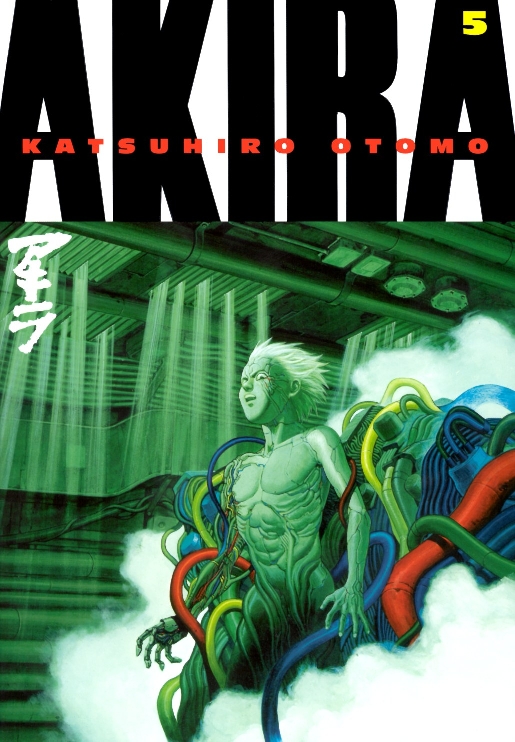 |
So far Hollywood has yet to do to Akira what it did to DragonBall. (The Nerd-o-sphere owes you, Patrick Willems!) Luc Besson, however, was able to incorporate memorable bits from the seminal manga turned anime into Lucy. Each is named for a nigh-omnipotent character within to make it that much harder to tell if someone is referring to the title character or the work as a whole. Much like Tetsuo and the other Espers in Neo-Tokyo, Lucy (played by ScarJo, who will next be seen directly whitewashing Major Motoko Kusanagi in Hollywood’s unnecessary live action bastardization of Ghost in the Shell) develops an astounding array of powers as the plot requires. She gains superpowers from a rare super-drug (this is the anti-Requiem for a Dream), which is an inversion of the Espers being given drugs to suppress their reality warping abilities. Like Akira, Lucy’s emotional connection to her humanity is inverse to her power level. The most obvious homage is at the end when Lucy sprouts assimilating tendrils. Both end with a trippy, transcendental paradigm shift, but Lucy could’ve been much more Akira-y if Lucy fought Bradley Cooper’s character from Limitless in a Paris-obliterating rampage beforehand.
5) Chronicle = Miracleman
Since the whole appeal of found-footage movies is they’re just like home videos except mildly interesting, it was only a matter of time until superpowers were added to the “genre.” Chronicle is The Blair Witch Project equivalent of a superhero origin story, except it’s way less boring and you can actually understand what happens at the end. Chronicle is a toned done version of Miracleman (or Marvelman, as it used to be called), this time a British knock-off of Captain Marvel. Like most of Alan Moore’s repertoire, he took a forgotten property and transformed it into a critical darling by “taking it seriously.” (In other words, he added rape and ultraviolence, but it’s okay when Moore does it because then it’s LITERARY rape and ultraviolence.)
Matt, Andrew and Steve enjoy carefree camaraderie upon being empowered, similar to the wholesome adventures of Miracleman, Kid Miracleman, and Young Miracleman, before Moore got to them. After a lifetime of abuse by his father and school bullies, Andrew goes on a superpowered rampage in Seattle that only Matt can stop because Steve was killed for being The Black Guy, like how after being abused and raped by bullies in his human form, Kid Miracleman goes on a superpowered rampage that massacres most of London. Matt is able to kill Andrew by telekinetically impaling him with a metal spear from a statue just like the fatally wounded Aza Chorn teleporting a girder through Kid Miracleman to force him to revert back to human so Miracleman could put him out of England’s misery.
 |
I’d wager the similarities are no fluke, although screenwriter Max Landis committed the unpardonable sin of confusing Titania with Maxima and Five For Fighting with Our Lady Peace in his video about The Death and Return of Superman. At first glance, gaining electromagnetic control from touching a mysterious object seems simpler than bodyswapping-alien hybridization- virtual reality of Miracleman’s Project Zarathustra retcon, until you hear his explanation of their powers. Landis insists that they were empowered by an ancient mineral creature capable of parasitically enslaving thralls, so like Starro the Star Conqueror, except neither an extraterrestrial nor an echinoderm. He probably should’ve led with that. Before the studio vetoed him, he planned the middle installment to focus on a tragic supervillainess. (Coincidentally, Neil Gaiman’s long unfinished Miracleman arc has Miraclewoman seemingly taking on an adversarial role.) Director Josh Trank won’t be able to helm any follow-up unless he successfully evades Marvel’s wetworks squad.
4) Unbreakable = Superman
The marketing team for Unbreakable definitely tried to make it as stealth a comic book movie as possible, much to writer/director M. Night Shyamalan’s chagrin. What was promoted as an ominous supernatural mystery turned out to be a superhero movie that’s as pretentious as it is dour and inept. The gist of it is that depressed and mild mannered David Dunn realizes he’s been invulnerable his whole life after becoming the sole survivor of a deadly train crash. This alliteratively named security guard embarks on a career as a budget-friendly Superman (think Golden Age before he was loaded up with various Kryptonian superpowers) in an industrial drab poncho once the fanboy Mr. Glass tells him that he’s proof that comics are real and that’s what superhumans are supposed to do. Dunn is also equipped with the ability to detect evildoers’ guilt, similar to Ghost Rider. Despite his powers and job experience, Dunn doesn’t do a great job rescuing people. His Kryptonite is the readily available molecule known as H20, which seems to be Shyamalan’s Siegfried’s Shoulder as well considering Signs and Lady In The Water.
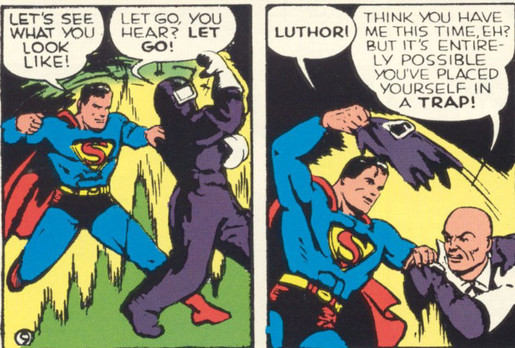 |
The twist ending is that Mr. Glass engineered the deaths of hundreds of people just to prove his hypothesis that there was someone as impervious as he is brittle. Since his osteogenesis imperfecta is a real medical ailment that afflicts multiple people rather than some totally unique condition, his hunch is extra insane. A lifetime of reading superhero comics conditioned him to believe he was destined for supervillainy because he was the opposite of their “might makes right” undertones. So the movie’s Lex Luthor expy’s goal was to kill a bunch of people in hopes of finding a guy who could challenge his later nefarious deeds even though he didn’t seem to have any criminal plans beyond this mass murder talent search.
This is so dunderheaded it merits repetition: the evil mastermind’s plan was literally to discover and enable someone to prevent himself from succeeding at being an effective evil mastermind. Did wearing purple remove all his sanity and wits? If a hero is defined by his villain, then David Dunn ought to hang up his poncho in abject embarrassment. So if you thought Superman Returns and Man of Steel missed the point of Superman, take solace in the fact that Shyamalan wasn’t able to make an official Superman movie. Fans of Avatar: The Last Airbender weren’t so fortunate.
3) RoboCop = Deathlok + Judge Dredd
RoboCop (and possibly RowboatCop) may be an update on Frankenstein in the broad strokes, but in the details he shares his origin with Marvel’s Deathlok. (I’d say the same thing about The Vindicator, but I might be alone in remembering that piece of Canuxploitation.) Both Luther Manning (the first of many cyborgs to keep the Deathlok trademark in play) and Alex Murphy (I would’ve gone with “Robert Kopp”) are fatally wounded and wind up having their bodies upgraded with cybernetic components including computer/brain uplinks by an unscrupulous military-industrial complex or the unscrupulous Omni Consumer Products. Both Manning and Murphy have a wife and son whom believe them to be dead as a source of further angst. The two cyborgs struggle to regain their humanity and turn against the corrupt forces that created them, like you do.
The real kicker is that Manning is also a Detroit native. RoboCop is sleek silver contours because his visuals were inspired by Marvel’s licensed Rom: SpaceKnight comic (which has a cameo in the movie) whereas Deathlok has a red tactical onesie that shows off his metal limbs. Sadly, when a live-action Deathlok (a brand new guy rather than Manning or his canon successors) appeared on Agents of SHIELD, he was dressed in a navy unitard with a laser tag vest because they budget for costuming went towards scenery for Bill Paxton to devour.
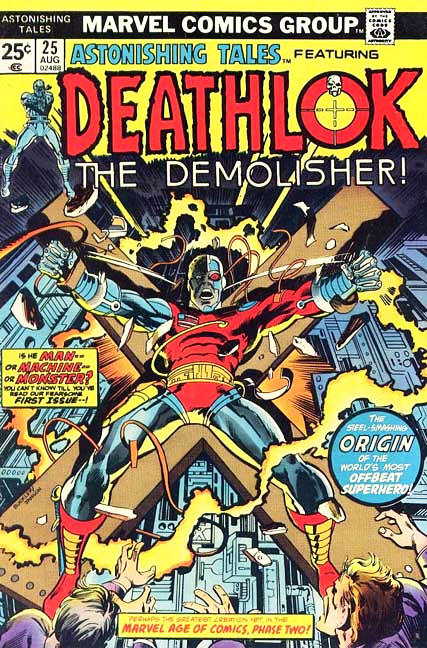 |
One feature that makes RoboCop’s creepy disembodied human face look less repulsive than Deathlok’s robo-zombie mug is his helmet, whose shape was influenced by those found in 2000 AD’s. Judge Dredd. It’s slightly distinct since it has a Cyclops visor slit, but unfortunately RoboCop can’t fire optic blasts from it. Apart from the mouth-exposing helm, the screenwriters used crime-ridden Mega-City One as the template for near-future Detroit. Remember, Detroit wasn’t quite the epitome of urban decay back in 1987 as it has now become. The privatization of Detroit’s police by OCP could be seen as the precursor to the inception of the draconian Judges. Judge Dredd and RoboCop are both obsessed with their occupations of enforcing the law to the letter, although Dredd doesn’t need a computer-brain interface to explain his superior job performance. Judge Dredd excels at satire at the expense of government, corporations, and the media. RoboCop lifted this brand of subversiveness so well that it frustrated plans to make the first Judge Dredd movie earlier, because they didn’t want the general public to mistake it for a cheap knock-off. If only the overrated Dredd reboot had RoboCop’s wit and personality it could’ve earned enough for a bat-guano mad sequel about the Dark Judges.
2) Salt = Black Widow
Once upon a time, at the dawn of the twenty-first century, there was going to be a Black Widow solo film and The Far-Reaching Philosophy of Edwin A. Salt starring Tom Cruise. Although both these projects fell through at different studios, they somehow merged together in Development Hell and were reborn as 2010’s Salt. The key factor that distinguished Salt from a sea of generic spy thrillers was the lead being recast with Angelina Jolie as Evelyn Salt (surprisingly they put a modicum of effort into not simply renaming the character Edwina). Salt is a Russian sleeper agent who infiltrated the CIA and goes on the lam from both sides when her cover is blown. Unlike Agent Carter, nobody pulls their punches on the resorceful and lethal Salt because of her gender. Although Salt was originally conceived as a sci-fi dystopia, the Cold War plot they ended up filming is exactly the sort of story that would highlight Black Widow as Marvel’s top spy if a studio couldn’t reference the rest of the Marvel Universe.
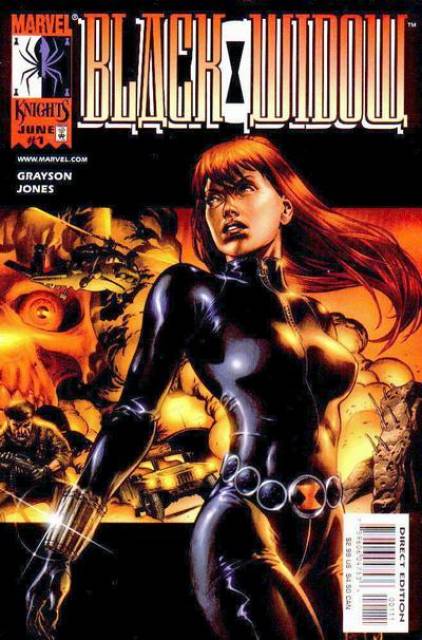 |
Furthermore, the film’s KA Program of indoctrinating Commie kids into ace spies indistinguishable from American citizens is similar to the comics’ Red Room Project (as seen on Agent Carter and probably Avengers: Age of Ultron) that turned Commie girls into superspies posing as Bolshoi ballerinas. Both women get dead husbands. Black Widow’s is a Soviet Supersoldier, although Liev Schreiber’s character (SPOILER that he personally spoiled on The Daily Show while promoting the movie) is an undercover approximation of the Red Guardian. Salt’s husband is an arachnologist from whom she obtains spider venom, which is an incredibly specific detail that immediately makes nerds think of the Avengers’ femme fatale. The icing on the “coincidence” cake is that Salt’s birthname is Natasha just like Black Widow. Sadly Jolie doesn’t get to rock a black catsuit with gold Widow’s Bite gauntlets, because this was before studios realized that ’70s political thriller throwbacks go over better with current audiences if they feature outlandish costumes. If only Marvel Studios had gotten Jolie to play Black Widow, we might’ve had an official solo movie of her by now.
1) The Sorcerer’s Apprentice = Doctor Strange
Marvel is set to release Doctor Strange in 2016 starring [insert clever malapropism of improbably named Limey otter posing as a human], but didn’t Disney already make one starring an even more overexposed actor? It was 2010’s The Sorcerer’s Apprentice. “But isn’t The Sorcerer’s Apprentice based on the most famous Fantasia sequence set to the Paul Dukas symphonic poem inspired by the Goethe ballad?” Well, someone accidentally greenlit a feature-length movie before noticing the source material was only nine minutes and didn’t buy the screenwriters enough drugs to enable them to write an entire movie about wizards fighting an uprising of sentient brooms. So they decided to lift the entire Doctor Strange framework to fill in the empty spaces of a movie which would otherwise be one scene. I’m guessing they chose not to steal from Doctor Fate instead because fear of mindboggling DC continuity trumped sticking it to Warner Bros.
 |
Nicholas “I used to pick roles carefully before I met crippling debt” Cage stars as Balthazar Blake, the Stephen Strange stand-in who looks like a derelict. (Cage also starred in Drive Angry, which feels like it might as well be another Ghost Rider movie except they use regular cars instead of an enchanted motorcycle and forgot to light his head on fire. He did a voiceover in G-Force too, but I have just been informed that is not an avant-garde retelling of Gatchaman.) Blake was a disciple of Merlin just as Strange was a disciple of the ancient wizard creatively named The Ancient One. Rival pupils (either Baron Karl Mordo or Maxim Horvath) betray their wizened teacher and ally with the inflammable Big Bad of Magic (Dormammu or Morgana le Fay). Strange and Blake are both smitten by a mauve-clad sorceress with awkward ties to their respective ultimate evil: Clea, and Veronica Gorloisen, who becomes bonded with Morgana. (Feel free to cast Alfred Molina as Baron Mordo and Monica Bellucci as Clea, actual Dr. Strange movie!) “The Prime Merlinian” is the film’s less generic but goofier equivalent title to “Sorcerer Supreme.” In present day NYC, Blake takes on physics student Dave as the eponymous apprentice, similar to how Strange was grounded as a surgeon before studying magic. So the movie doubles down on Dr. Strange analogues at the expense of his problematic manservant, Wong. To compensate, Dave’s girlfriend is named Becky Barnes, which is close enough to Bucky Barnes.
What I’m getting at is that Disney bought Marvel in 2009 primarily to head off a copyright infringement suit. Or perhaps the striking similarities are just a side effect of an honest attempt to rip off Dr. Mordrid.
You may remember Matthew Catania from such Daily Lists as
The Top 14 X-Men Characters That Still Need Marvel Legends Action Figures
10 Reasons Why The 100 Is the Best Show You’re (Probably) Not Watching
10 Things That Must Be in a Live-Action The Tick Relaunch
12 Marvel Characters That Need To Appear on Agent Carter
8 Reasons Why Marvel Studios Won’t Make A Comics Accurate Howard The Duck Movie
The 10 Least Terrible SyFy Channel Original Movies (Sorry, Sharknado!)
10 Characters That Should Appear on Arrow Season 3
The 10 Worst Adaptations of X-Men on Film (So Far)
10 Ways to Make a Wonder Woman Movie Not Suck
Top Ten Reasons X-Men and Doctor Who Are Secretly the Same Franchise
Eight Reasons Why a Superman/Batman Movie Might Not Be Such a Great Idea
